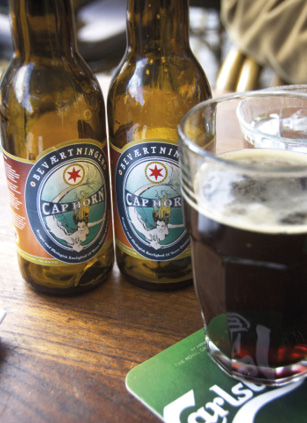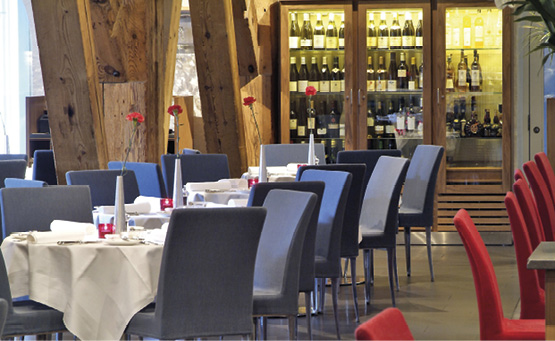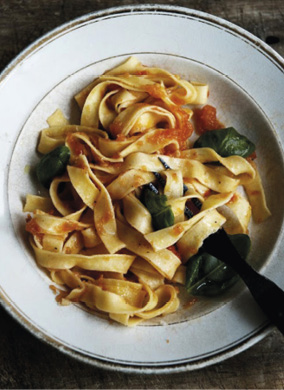Nyhavn and Frederiksstaden
Packed with busy bars and restaurants, canalside Nyhavn attracts thousands of visitors thanks to its pretty postcard setting. In 2016, the long-awaited Inderhavnsbro (Inner Harbour Bridge) opened, connecting foot and bike traffic from Nyhavn to Christianshavn. To Nyhavn’s north are the elegant Rococo houses of Frederiksstaden, built as a grand symbol of Frederik V’s reign. The huge dome of the Marmorkirken dominates the skyline, while three main streets divide the area: Store Kongensgade, lined with galleries, restaurants and high-end shops; quieter Bredgade; and cobbled Amaliegade, which bisects the palaces of Amalienborg – the royals’ official winter residence. All three streets lead up to Christian IV’s impressive defensive fortress, the grass-bastioned Kastellet. Finally, perched on a lonely rock off the Kastellet’s northern edge, is the city’s most famous icon – the diminutive Little Mermaid.

Nyhavn
Picturesque Nyhavn is perhaps the city’s most popular tourist hangout. The “new harbour” was created in 1671 to link Kongens Nytorv to the sea – the earliest of the townhouses, no. 9, dates from this period – and has been home to some famous residents: Hans Christian Andersen lived at no. 67 for twenty years, but also at nos. 20 and 18. The area has not always been so salubrious: Nyhavn went through a long period as the city’s most disreputable red-light district before its transformation into the welcoming visitor haunt of today. On a sunny summer’s evening (there are outdoor heaters in winter), it’s easy to see the attraction of sipping a beer while gazing over the historic yachts (usually) moored in the harbour. Be warned, though: food and drink do not come cheap.
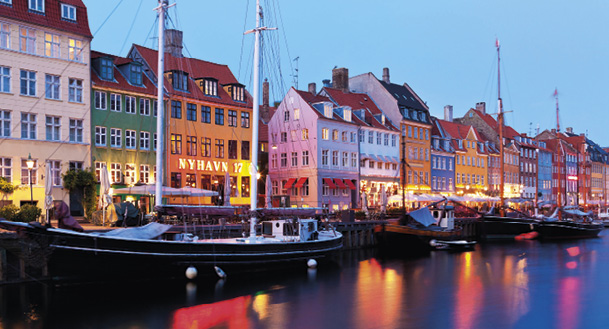
Nyhavn
Kunsthal Charlottenborg
Nyhavn 2 ![]() 33 74 46 39,
33 74 46 39, ![]() charlottenborg.dk. Tues & Thurs–Sun 11am–5pm, Wed 11am–8pm; 75kr.
charlottenborg.dk. Tues & Thurs–Sun 11am–5pm, Wed 11am–8pm; 75kr.
Located between Kongens Nytorv and Nyhavn (and with entrances on both) the Kunsthal Charlottenborg is housed in one of the least prepossessing palaces in Copenhagen. Built for the illegitimate son of Frederik III, it has since 1754 been home to the Royal Danish Academy of Fine Arts. There are no permanent displays but changing exhibitions of modern art are put on in the newer building (added in 1883) behind. One such exhibition in 1971, about the new hippie movement, triggered the founding of Christiania.
Amalienborg
The winter residence of the Danish royal family, Amalienborg is made up four almost identical Rococo palaces, arranged symmetrically around an octagonal courtyard that centres on a statue of Frederik V on horseback. Designed by royal architect Nicolai Eigtved in 1750, the palaces were originally built for (and funded by) wealthy Danish nobles, though the royals commandeered them following the devastating fire at Christiansborg in 1794. Today all four palaces are named both after their original benefactor and a subsequent resident royal. The Queen lives in Christian IX’s Palæ – or Schacks Palæ – with her husband Prince Henrik, while Frederik VIII’s Palæ (Brockdorffs Palæ) is home to Crown Prince Frederik and family; both are completely off-limits.
Note too that Christian VII’s Palæ (also known as Moltkes Palæ), whose fabulous Great Hall is considered to be one of the finest Rococo rooms in Europe, is unfortunately no longer open to the public.
You can, however, visit Christian VIII’s Palæ (Levetzaus Palæ), the first floor of which contains the Amalienborgmuseet (Amalienborg Museum; May–Oct daily 10am–4pm; Nov–April Tues–Sun 11am–4pm; 95kr; ![]() kongernessamling.dk), devoted to more recent royal history. The studies of each of the last three kings have been fully reconstructed (complete with vast pipe collections and family portraits), giving a flavour of their modern if by no means luxurious lifestyles.
kongernessamling.dk), devoted to more recent royal history. The studies of each of the last three kings have been fully reconstructed (complete with vast pipe collections and family portraits), giving a flavour of their modern if by no means luxurious lifestyles.
Outside on the courtyard, the changing of the guard ceremony at noon each day is a great hit with kids. Childish souls may try to see if they can induce the bearskin-wearing guard to flinch – chances are they won’t.
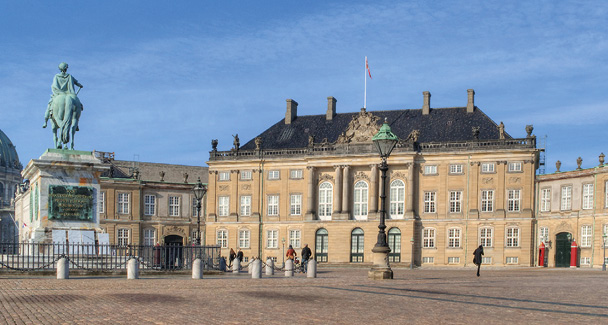
Amalienborg
Skuespilhuset
Sankt Annæ Plads 36 ![]() 33 69 69 33,
33 69 69 33, ![]() kglteater.dk. Guided tours (75min) 120kr; check website for times.
kglteater.dk. Guided tours (75min) 120kr; check website for times.
Completed in 2008, the Skuespilhuset (Playhouse), around the corner from Nyhavn, is widely agreed to be one of the city’s most elegant new buildings. It has a stunning position on the Inner Harbour, with a projecting upper storey that appears to be balancing precariously over the water’s edge. A copper-clad tower thrusts skyward from within, while a wooden promenade encircles the building and doubles as an outdoor café. To see the inside, either join one of the irregular tours or take in a performance – although productions here are almost exclusively staged in Danish.
Marmorkirken
Frederiksgade 4 ![]() 33 15 01 44, marmorkirken.dk. Mon–Thurs & Sat 10am–5pm, Fri & Sun noon–5pm. Free.
33 15 01 44, marmorkirken.dk. Mon–Thurs & Sat 10am–5pm, Fri & Sun noon–5pm. Free.
Partly inspired by St Peter’s Basilica in Rome, the Marmorkirken (Marble Church), which is properly called Frederiks Kirke, took almost 150 years to complete. Commissioned by Frederik V in 1749, the original designs by Nicolai Eigtved were modified by the French architect Nicolas-Henri Jardin. Twenty years later, construction was halted due to lack of funds. Languishing in ruins for more than a century, the church was only completed in 1894 using cheaper marble, paid for by Carl Frederik Tietgen, a leading Danish industrialist and entrepreneur.
Though the area around the church is under construction until 2019 (as part of the new Metro extension), it is still easy enough to access the building, which is dominated by a colossal copper-roofed dome some 31m in diameter. The interior is no less impressive: completely circular in plan and with twelve arched openings around its perimeter.
If you arrive at the right time (Aug daily 1pm & 3pm; Sept–July Sat & Sun 1pm & 3pm; 25kr), you can join a tour to climb the 260 steps to the top of the dome, from which there are spectacular views down over diminutive Copenhagen beneath you and towards the Swedish coastline in the distance. Note too how the relatively new Operaen across the harbour has been aligned perfectly with the Marmorkirken and Amalienborg.
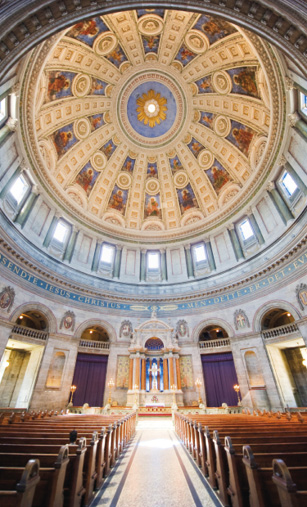
Marmorkirken
Designmuseum Danmark
Bredgade 68 ![]() 33 18 56 56,
33 18 56 56, ![]() designmuseum.dk. Tues & Thurs–Sun 11am–5pm, Wed 11am–9pm. 100kr.
designmuseum.dk. Tues & Thurs–Sun 11am–5pm, Wed 11am–9pm. 100kr.
Formerly the Kunstindustrimuseet, and not to be confused with the (now closed) Danish Design Center, this temple to (predominantly Danish) design occupies the four wings of the old Frederiks Hospital. Pride of place among the permanent exhibitions goes to the section on twentieth-century Danish applied art and craft, which takes in the full range of the iconic designs that have given Denmark its international reputation – from Arne Jacobsen’s Ant chair to Kaj Bojesen’s classic wooden toy monkey and Ole Kirk Christiansen’s Lego brick. Elsewhere, the collection traces the history of European and Asian applied and decorative art, with the emphasis on how it relates to the development of Danish design. The Asian collection is particularly strong – ranging from Japanese sword paraphernalia to Chinese Ming vases. Check out the selection in the museum shop if you fancy taking any pieces home with you.

Designmuseum Danmark
Kastellet
Daily 6am–10pm.
Surrounded by grassy ramparts and a series of moats, Copenhagen’s quaint Kastellet (Citadel) is one of the best-preserved star-shaped fortresses in northern Europe. Brainchild of Christian IV and completed by Frederik III, it was constructed to defend the city from all sides, including from the city itself in case of rebellion. Its terraced rows of immaculate, mansard-roofed barracks, painted in warm red hues, are still occupied by troops, making this also one of Europe’s oldest functioning military bases. The granite war memorial in its southwest corner, dedicated to the many Danish soldiers who have been lost in action around the world since 1948, was unveiled in 2011.
The Danish Resistance
Despite pledging to remain neutral during World War II, Denmark was occupied by German forces from April 9, 1940 until May 1945. While the occupation was not the bloodbath that unfurled elsewhere in Europe, resistance groups nonetheless sprung up, among them the “Churchill Club”, a group of schoolboys who sabotaged German vehicles, and the Hvidsten Group (subject of a hit 2012 Danish film) which distributed British weapons from secret airdrops. One of the proudest moments of this period was the clandestine evacuation in October 1943 of the vast majority of Denmark’s seven thousand Jews to safety in neutral Sweden; almost everyone seems to have an uncle or grandfather who was somehow involved.
Until recently the best place to get to grips with the Danish wartime experience was the Frihedsmuseet (Museum of Freedom, or Museum of Danish Resistance) at 7 Churchillparken. Sadly, on May 5, 2013, the museum was ravaged by fire – a tragedy attributed to arson. Fortunately, no archival records or artefacts – such as Himmler’s eye patch, taken off him by the Allies as he was captured trying to flee in disguise – were lost in the blaze. At the time of press, the new building has been designed but is not due for completion until 2019. In the meantime, the Ryvangen Memorial Park in Hellerup commemorates resistance fighters executed by the Nazis.
The Little Mermaid
Sitting on a boulder in the Inner Harbour off the northern edge of Kastellet, looking forlornly out to sea, The Little Mermaid (Den lille havfrue) is the city’s most famous symbol. The embodiment of Hans Christian Andersen’s fairy-tale character, she was created by Danish sculptor Edvard Eriksen in 1913 and paid for by Carlsberg brewery magnate Carl Jakobsen. Considering her diminutive size and somewhat vacant facial expression, the cynical observer might find it difficult to fathom her appeal to the busloads of tourists that visit her 24 hours a day, though her tragic tale of doomed love for her dream prince still has a powerful hold on the Danish imagination. The statue has not had an easy life, either. She’s been the frequent victim of radical groups, covered in paint several times and beheaded twice.
A more recent addition a few hundred metres to the north along the waterfront at Langeliniekaj, the Little Mermaid’s iconoclastic “ugly sister” is far more entertaining. Part of Bjørn Nørgaard’s sculpture garden The Genetically Modified Paradise, she sits like her older sister on a boulder in the water, but with body and limbs grotesquely elongated and contorted – perhaps a truer rendition of Andersen’s Little Mermaid’s suffering than the original statue.

The Little Mermaid
< Back to Nyhavn and Frederiksstaden
_Sarah_Coghill_AlmanakSTA134.jpg)
